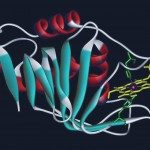Link to Pubmed [PMID] – 14600202
Protein Eng. 2003 Oct;16(10):733-8
Although the immunoglobulin-like beta-sandwich fold has no specifically conserved function, some common structural features have been observed, in particular a structural motif, the tyrosine corner. Such a motif was described in neocarzinostatin (NCS), a bacterial protein the structure of which is very similar to that of the immunoglobulin domain. Compared with the other beta-sheet proteins, the NCS ‘tyrosine corner’ presents non-standard structural features. To investigate the role of this motif in the NCS structure and stability, we studied the properties of a mutant where the H bond interaction had been eliminated by replacing the tyrosine with a phenylalanine. This mutation costs 4.0 kcal/mol showing that the NCS ‘tyrosine corner’ is involved in protein stability as in the other Greek key proteins. This destabilization is accompanied by remote structural effects, including modification of the binding properties, suggesting an increase in the internal flexibility of the protein. With a view to using this protein for drug targeting, these results along with those obtained previously allow us to define clearly the limitations of the modifications that can be performed on this scaffold.
